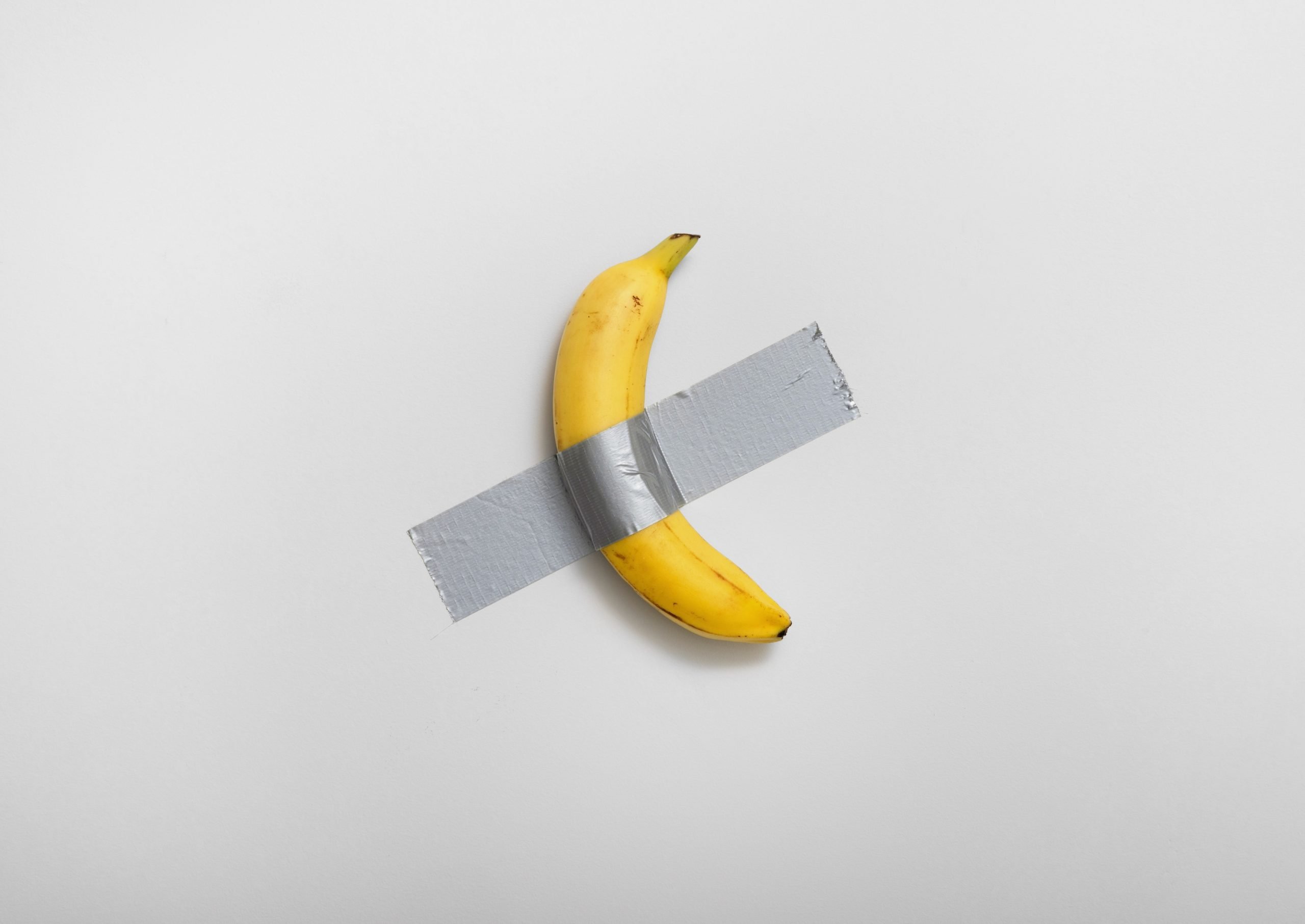
Sotheby’s delivered an unprecedented moment in art, and auction, history tonight in New York, selling artist Maurizio Cattelan’s Comedian (2019)—a banana taped to a wall—for $6.2 million, including buyer’s premium.
The auction was packed both in the room at the house’s Upper East Side location and in its virtual viewing room, where commentators quipped, “We’re only here for the banana dude,” and, “The world has gone bananas.”
The house offered the banana early in its prestigious evening sale of contemporary art, and advertised that it was accepting crypto payments. Auctioneer Oliver Barker introduced the lot to the crowd as a “viral sensation that has skyrocketed to universal recognition . . . here it is in all its splendor.”
The bidding began at $800,000 and quickly rose beyond $1 million, with bids being lobbed inside the room, on the phone, and online. The action paused at $2.2 million with an online bid, but picked back up, thanks primarily to activity from online bidders. Specialist Jen Hua placed the winning bid on behalf of crypto king Justin Sun, who naturally paid in crypto. “This is not just an artwork,” Sun said in a statement to Sotheby’s, “it represents a cultural phenomenon that bridges the worlds of art, memes, and the cryptocurrency community. I believe this piece will inspire more thought and discussion in the future and will become a part of history.”
The infamous fruit was destined to sell, regardless of the bidding in the room, since it carried a guarantee from Sotheby’s, which estimated it at $1 million to $1.5 million. The low estimate alone represented a substantial markup from the $120,000 to $150,000 that editions of the work sold for at Art Basel Miami Beach in 2019. (Cattelan conceived the piece as an edition of three plus two artist’s proofs.)
Cattelan’s Comedian ignited shock and awe when it was unveiled by the Perrotin gallery at the fair. As Artnet’s Sarah Cascone reported at the time, an anonymous donor acquired one edition for the Guggenheim Museum.
The artwork comes with some interesting logistical issues. While the original banana on view was sourced from a local Florida supermarket, the owner of the work has the responsibility of replacing the banana as necessary. That is correct: $1 million does not actually buy any fruit—or the tape needed to complete the work, for that matter. All in all, though, it’s a fairly simple piece to care for, unlike many other examples of perishable contemporary art.
As a potentially edible artwork, it comes as no surprise that the banana was eaten not once, but twice. First by performance artist David Datuna at Miami Basel, where he coyly commented that it was tasty, but had “too much duct tape.” Perrotin staffers quickly replaced the fruit, but the frenzy surrounding the artwork was enough for the gallery to remove it from the final day of the fair. In 2023, a South Korean art student peeled the work from the wall at the Leeum Museum of Art in Seoul and downed it while his friend recorded the act.
Fairgoers take pictures of Maurizio Cattelan’s Comedian, for sale from Perrotin at Art Basel Miami Beach. Photo by Sarah Cascone.
Last month, Artnet’s Katya Kazakina reported that the consignment to Sotheby’s was orchestrated by Andre Sakhai, a patron of the Institute of Contemporary Art, Miami, and a known art trader. At one point, according to a person familiar with the deal, Sakhai was seeking a $2 million guarantee.
Prior to the sale, Sotheby’s housed the duct-taped banana—which looked like it was nearing the end of its shelf life (or should we say wall life?), in a custom-built structure with an arched entryway at its York Avenue headquarters. The banana, which had its own security stationed nearby, looked small against the pristine white wall. The piece of produce a short distance away from paintings by canonical figures like Monet, Picasso, and Warhol, which carried their own seven-figure estimates.
In a catalogue essay on the banana, a Sotheby’s expert wrote, “No other artwork from the 21st century has provoked scandal, sparked imagination, and upended the very definition of contemporary art like Maurizio Cattelan’s Comedian. . . [It] belongs to the rare league of artworks that need no introduction, having quickly erupted into a viral global sensation that drew record crowds, social media inundation, landed the cover of the New York Post, and divided viewers and critics alike. Passionately debated, rhapsodically venerated, and hotly contested… the work headlined news stories shared around the world, becoming the most talked-about artwork of the century.”
A journalist looks at Italian visual artist Maurizio Cattelan’s duct-taped Banana entitled Comedian displayed during a media preview at Sotheby’s in New York, on November 8, 2024. Photo by Kena Betancur/AFP via Getty Images.
For some viewers, the artwork is emblematic of the decadent, opaque dealings of an elitist art world, where value is arbitrarily assigned. It has spawned memes and parodies, merchandise, and for Sotheby’s, a dramatic marketing campaign. But it’s very much within the wheelhouse of its creator, who is himself something of a comedian. A central aspect of Cattelan’s work is based on the “idea of his sculpture breaking in to a place in which it does not belong,” another specialist says in a promotional video for the work. Now, though, it has certainly secured its place within the hallowed halls of art’s elite.